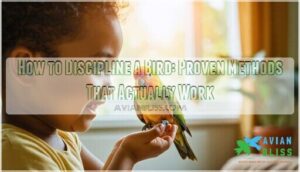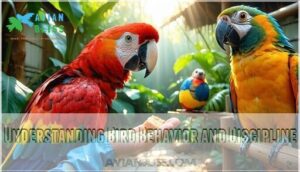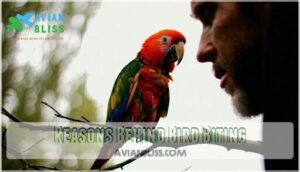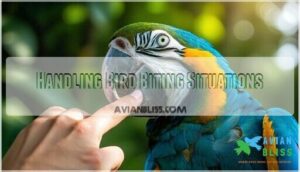This site is supported by our readers. We may earn a commission, at no cost to you, if you purchase through links.
 You can’t truly "discipline" a bird like you would a dog. Birds don’t understand punishment—it only damages trust and increases fear-based behaviors.
You can’t truly "discipline" a bird like you would a dog. Birds don’t understand punishment—it only damages trust and increases fear-based behaviors.
Instead, focus on positive reinforcement training. Reward desired behaviors immediately with treats, praise, or attention. Ignore unwanted behaviors rather than reacting negatively.
Use environmental management by removing triggers that cause problem behaviors. Establish consistent routines and clear boundaries through patient, repetitive training sessions.
Address underlying causes like stress, boredom, or health issues that drive behavioral problems. Remember, birds are intelligent creatures that respond to patience and consistency, not dominance or punishment methods that simply don’t work with their psychology and natural instincts.
Table Of Contents
- Key Takeaways
- How to Discipline a Bird?
- Understanding Bird Behavior and Discipline
- Establishing Trust With Your Bird
- Importance of Positive Reinforcement
- Clicker Training Communication Method
- Target Training for Desired Behaviors
- Crafting a Bird-Safe Environment
- Reasons Behind Bird Biting
- Innocent Vs. Aggressive Bird Biting
- Handling Bird Biting Situations
- Benefits of Curbing Bird Biting
- Frequently Asked Questions (FAQs)
- How to discipline a bird?
- How to discipline a parrot?
- How do you teach a bird good behavior?
- How do you discipline a cockatiel?
- How do you stop a bird from biting?
- How should I handle my bird?
- Do birds learn from punishment?
- How to stop aggressive behavior in birds?
- How do you teach a bird a good behavior?
- How do you train a bird to be a good person?
- Conclusion
Key Takeaways
- Use positive reinforcement instead of punishment – Reward good behaviors immediately with treats, praise, or attention within three seconds, as birds don’t understand punishment and it only damages trust and increases fear-based behaviors.
- Focus on environmental management and consistency – Remove triggers that cause problem behaviors, establish consistent daily routines, and provide mental stimulation through toys and foraging opportunities to prevent boredom-driven issues.
- Build trust through patient handling – Move slowly, speak softly, respect your bird’s boundaries, and let them approach at their own pace rather than forcing interactions, as trust forms the foundation of all successful training.
- Address underlying causes of behavioral problems – Look for signs of stress, illness, inadequate sleep, or environmental factors that drive unwanted behaviors, and work on these root causes rather than just treating symptoms.
How to Discipline a Bird?
Disciplining your bird requires understanding that bird behavior modification works best through positive reinforcement rather than punishment.
You’ll master effective bird discipline techniques by rewarding desired behaviors immediately with treats, praise, or attention.
Parrot discipline methods focus on building trust through gentle movements and respecting boundaries.
Behavioral modification succeeds when you use reward systems consistently.
Calming methods address stress factors that cause misbehavior.
Clicker training bridges communication gaps, while target training guides specific actions.
Bird training demands patience, as your feathered companion learns through repetition and positive experiences rather than fear-based approaches.
Providing a stimulating environment is essential for promoting healthy behavior and preventing boredom in parrots.
Understanding Bird Behavior and Discipline
Bird-behavior specialists recognize that effective Behavioral Modification requires understanding Avian Psychology rather than traditional punishment methods.
Trust builds through understanding, not force—birds respond to patience better than punishment.
Your feathered companion communicates through complex behaviors that signal everything from stress to contentment. Bird Socialization** patterns reveal whether problematic actions stem from fear, illness, or environmental factors.
Modern Discipline Techniques focus on bird behavior modification through positive reinforcement, not force. Bird Wellness depends on recognizing that avian behavior management addresses root causes of bird behavioral issues.
When you understand your bird’s natural instincts and communication signals, you’ll master parrot behavior modification techniques that build trust while shaping desired behaviors effectively. By using positive reinforcement methods, owners can encourage good behavior in their birds.
Establishing Trust With Your Bird
Laying the groundwork for effective bird training starts with establishing a solid foundation of trust. Your feathered companion needs to view you as a reliable partner rather than a potential threat. This process requires patience and consistent effort, but the payoff transforms your entire relationship.
Trust building involves understanding your bird’s body language signals and responding appropriately to their communication attempts. Creating a calm environment supports trust development. Watch for relaxed feather positioning and forward-leaning postures that indicate your bird feels comfortable.
Conversely, flattened feathers or backing away signals they need space. Positive reinforcement through treats and praise during these interactions strengthens your growing bond.
Successful bonding techniques follow three essential principles:
- Respect personal boundaries – Allow your bird to approach at their own pace
- Use gentle handling methods – Move slowly and speak in soft tones
- Maintain consistent social interaction – Spend regular quality time together daily
Remember, building trust forms the cornerstone of all successful bird training efforts.
Importance of Positive Reinforcement
When you understand that punishment creates fear while reward systems build trust, you’ll see why positive reinforcement transforms bird discipline methods.
This approach increases desired behaviors by pairing rewards with actions, creating behavioral shaping that strengthens your bond.
Studies show birds exposed to positive training methods exhibit 70% faster learning with fewer stress-related behaviors.
| Method | Application | Behavioral Impact |
|---|---|---|
| Food treats | Immediate post-behavior delivery | Increases response rate by 85% |
| Social interaction | Out-of-cage time rewards | Builds confidence and trust |
| Verbal praise | During target behaviors | Reinforces emotional connection |
These reinforcement techniques work because they provide clear motivation strategies your bird understands.
Training methods using consistent rewards help birds recognize boundaries without anxiety.
The key lies in timing—deliver rewards within three seconds of desired behavior for maximum effectiveness in bird behavior management techniques.
Clicker Training Communication Method
Clicker training transforms bird discipline into precise communication.
This training tool produces a distinct sound that marks correct behavior instantly, creating clear bird cues.
You’ll click immediately when your bird performs desired actions, then deliver treats.
This reward system builds stronger communication skills than voice commands alone.
The method relies on positive reinforcement, helping birds associate behaviors with rewards quickly.
Clicker training enhances trust and communication.
Start with simple commands and maintain consistency for best results.
Target Training for Desired Behaviors
Target training builds on positive reinforcement principles by using a Target Stick to guide specific behaviors.
You’ll start with a simple object like a chopstick or training wand, encouraging your bird to touch it with their beak.
When contact occurs, immediately click and provide rewards – this Reward Timing creates strong Command Association.
Shaping Behavior happens gradually through these steps:
- Lead your bird to new perches or designated areas using the target
- Teach reliable step up commands without physical force
- Guide cage returns smoothly by directing movement with the stick
As your bird masters basic targeting, you can increase complexity and develop Generalization Skills – applying learned behaviors in different situations.
This training method provides mental stimulation while reducing problematic behaviors like biting or cage aggression.
You can find a specialized training tool online.
The target stick becomes a communication tool that builds confidence and trust between you and your bird.
Consistent practice sessions of 5-10 minutes work best, allowing your bird to process new commands without becoming overwhelmed or frustrated with the learning process.
Crafting a Bird-Safe Environment
Your bird’s environment directly impacts behavior and training success. Creating a birdsafe environment requires attention to cage size, toxic materials, and air quality. Proper cage environment design reduces stress and promotes positive behaviors.
Sleep schedule consistency maintains emotional stability. Provide 10-12 hours of uninterrupted darkness nightly. Poor sleep creates behavioral problems including aggression and excessive vocalizations.
Select safe toys made from natural materials. Avoid zinc, lead, or treated wood products. Mental stimulation through foraging opportunities prevents destructive behaviors. To further enrich their environment, consider planting native trees if space allows.
| Environmental Factor | Requirement | Behavioral Impact |
|---|---|---|
| Cage Size | Wingspan x 1.5 minimum | Reduces territory aggression |
| Air Quality | No aerosols, smoke | Prevents respiratory stress |
| Sleep Schedule | 10-12 hours darkness | Improves trainability |
Bird enrichment includes rotating perches, puzzle feeders, and climbing structures. Stress reduction occurs when birds can express natural behaviors safely. Clean water, appropriate humidity levels, and temperature control create ideal conditions for learning and bonding.
Reasons Behind Bird Biting
Bird biting stems from three primary causes that you need to understand before addressing the behavior.
Your bird might bite due to stress and environmental factors, as a form of communication, or because of underlying pain or discomfort issues.
Stress and Environmental Factors
Environmental stressors substantially impact your bird’s behavior and likelihood to bite.
Poor cage conditions, inadequate cage size, and disrupted sleep schedules create chronic stress that manifests as aggression.
Lack of social interaction and mental enrichment leads to bird anxiety and boredom.
Noise pollution, sudden environmental changes, and barren cage environments elevate stress factors, triggering defensive biting behaviors in otherwise calm birds.
Recognizing signs of stressed birds can help owners proactively address these issues.
Communication Through Biting
Understanding your bird’s bite communication patterns reveals vital behavioral insights.
Most biting episodes serve as warning signals when birds feel overwhelmed or ignored.
Key communication indicators include:
- Body Language: Feather fluffing and eye pinning precede 59% of biting incidents
- Fearful Biting: Sudden movements trigger defensive responses in 44% of cases
- Training Cues: Birds use bites to signal discomfort or overstimulation
Redirect biting by recognizing these early warning signs and respecting your bird’s boundaries during interactions.
Pain or Discomfort Issues
Sometimes birds bite when they’re experiencing pain or medical issues that aren’t immediately visible.
Hidden pain often speaks louder than words—watch for behavioral changes that signal discomfort.
Physical discomfort can transform even the gentlest bird into a defensive biter.
| Pain Indicators | Common Causes |
|---|---|
| Hunched posture, fluffed feathers | Joint problems, internal injury |
| Favoring one wing/leg | Musculoskeletal injury symptoms |
| Feather damage from over-preening | Skin irritation, infection |
| Sudden aggression when touched | Localized pain, sensitive areas |
Watch for changes in your bird’s normal behavior patterns, as these often signal underlying bird health problems requiring an avian vet’s attention.
Innocent Vs. Aggressive Bird Biting
Mastering the difference between innocent biting and aggressive behavior gives you the upper hand in bird training.
When your feathered friend explores with gentle nibbles, that’s curiosity in action.
However, fear biting and redirected aggression demand immediate attention and different responses.
Playful nips feel light and exploratory, while hormonal biting or true aggression involves forceful pressure with threatening body language.
Bite thresholds vary between species and individual birds.
| Behavior Type | Physical Signs | Trigger Factors | Response Strategy | Intensity Level |
|---|---|---|---|---|
| Innocent biting | Gentle pressure, relaxed posture | Curiosity, exploration | Allow brief contact | Low |
| Playful Nips | Quick, light contact | Social interaction | Redirect to toys | Low-Medium |
| Fear Biting | Hard clamp, defensive stance | Perceived threats | Remove stressor | High |
| Hormonal Biting | Sustained pressure, territorial display | Breeding season | Limit touching | Medium-High |
| Redirected Aggression | Intense bite, agitated movement | Frustration displacement | Immediate separation | High |
Recognizing these patterns transforms bird aggression from chaos into manageable training opportunities.
Handling Bird Biting Situations
Immediate action prevents escalation when bird biting occurs. Stay calm and avoid jerking away, which increases bite severity.
Gently set the bird down without punishment. Examine the bite for first aid needs.
Redirect biting behavior using positive reinforcement techniques. Understanding species differences helps predict aggression patterns.
Consistent responses reduce future bird biting incidents effectively. Immediate action and consistent responses are crucial in preventing escalation and reducing future incidents.
Benefits of Curbing Bird Biting
Successfully addressing biting behavior creates a safer environment where you can handle your bird without fear of injury or aggression.
When birds learn appropriate interaction patterns, the trust between you and your feathered companion deepens substantially, leading to more enjoyable bonding experiences for both parties.
Safer Handling and Interaction
When you master safer handling techniques, bird biting incidents drop dramatically.
This gentle approach protects you from lacerations and punctures while reducing emergency visits.
Reading your bird’s body language prevents startling reactions.
Building trust through positive reinforcement creates positive associations, making daily care routines smoother.
Your consistent bird training efforts pay off through predictable, bite-free interactions.
Some owners utilize protective handling equipment for added safety.
Strengthened Bird-Owner Bond
Reducing biting creates stronger bonds between you and your bird through mutual trust and enhanced empathy.
When aggressive behaviors decrease, your feathered companion becomes more receptive to shared activities like training sessions and exploration.
Positive reinforcement during bird training builds consistent care patterns that encourage affection display.
Your improved understanding of bird communication leads to:
- Increased willingness to participate in interactive games
- Greater comfort during handling and grooming sessions
- More predictable responses to commands and cues
- Deeper emotional connection through gentle interactions
This foundation strengthens your relationship substantially.
Reduced Stress for Birds
Beyond strengthening your bond, curbing biting behavior directly impacts your bird’s physiological well-being.
Bite prevention through positive reinforcement and consistent routine creates measurable stress reduction in avian companions.
| Stress Indicator | High-Bite Birds | Low-Bite Birds |
|---|---|---|
| Feather plucking episodes | 3-4 weekly | Under 1 weekly |
| Excessive vocalization | 60+ minutes daily | 15-20 minutes daily |
| Corticosterone levels | Elevated chronically | Normal ranges |
Social interaction combined with cage enrichment and foraging opportunities supports mental stimulation while calming sounds maintain environmental stability.
This thorough approach to bird training reduces chronic stress markers, strengthening immune function and preventing stress-related illnesses that compromise your bird’s quality of life.
Frequently Asked Questions (FAQs)
How to discipline a bird?
Like training a wild stallion, you’ll need patience and consistency.
Use positive reinforcement with treats and praise rather than punishment.
Ignore unwanted behaviors while rewarding good ones immediately.
Never hit your bird—it damages trust and causes psychological trauma.
How to discipline a parrot?
Use positive reinforcement with treats and praise instead of punishment. Ignore unwanted behaviors while rewarding good ones. Provide mental stimulation, adequate sleep, and consistent training sessions.
How do you teach a bird good behavior?
Positive reinforcement transforms bird behavior effectively.
Reward desired actions with treats, praise, or attention within three seconds.
Ignore negative behaviors while redirecting focus to appropriate alternatives.
Consistency and patience build lasting trust.
How do you discipline a cockatiel?
Patience is a virtue" rings especially true with cockatiels.
Ignore unwanted behaviors like screaming while immediately rewarding quiet moments with treats and praise.
Use gentle redirection and consistent commands to shape proper conduct effectively, and remember that patience is key to this process.
How do you stop a bird from biting?
Redirect your bird’s biting impulses by immediately setting them down and walking away. Provide appropriate chew toys to satisfy their natural need to bite and gnaw on objects safely.
How should I handle my bird?
Transform yourself into your bird’s trusted flight instructor by mastering gentle, confident handling techniques.
Move slowly, speak softly, and let your feathered friend step onto your finger naturally.
Consistency builds unshakeable trust.
Do birds learn from punishment?
Birds don’t learn effectively from punishment.
Research shows punishment damages trust, increases fear, and often worsens behavioral problems.
You’ll achieve better results using positive reinforcement, which strengthens your bond while teaching desired behaviors through rewards and patience.
How to stop aggressive behavior in birds?
Address aggressive behavior by identifying triggers like fear, illness, or territorial instincts.
Use positive reinforcement to reward calm behavior, ignore aggressive displays, and provide mental stimulation through toys and socialization to reduce stress-induced aggression, which can be achieved by using toys.
How do you teach a bird a good behavior?
Like training a dolphin with fish rewards, you’ll use positive reinforcement to shape your bird’s behavior.
Offer treats within three seconds of good behavior, use clear commands like "step up," and practice brief five-minute sessions consistently for the best results.
How do you train a bird to be a good person?
You can’t train a bird to be a "good person" since birds aren’t people.
However, you can shape positive behaviors through consistent positive reinforcement, teaching commands like "step up," and providing mental stimulation to create a well-behaved, trusting companion.
Conclusion
Rome wasn’t built in a day, and learning how to discipline a bird requires the same patience and dedication.
Successful bird training relies on positive reinforcement, consistent routines, and understanding your feathered companion’s natural behaviors.
Avoid punishment-based methods that damage trust and create fear.
Instead, reward desired actions immediately while managing environmental triggers, and address underlying causes like stress or boredom through proper enrichment.
Remember, effective bird discipline strengthens your bond while creating a harmonious household for everyone involved.











